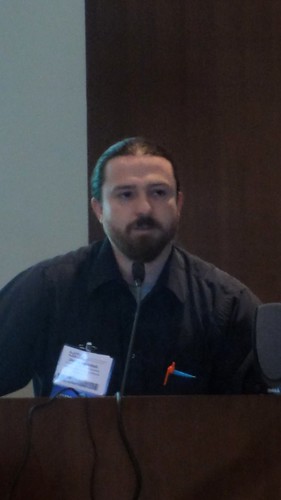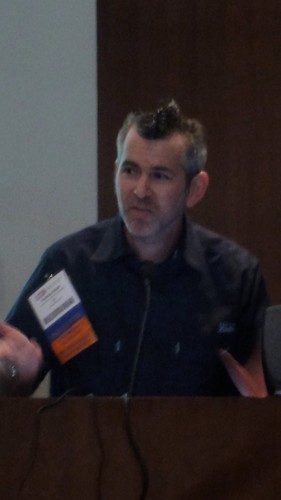 |
|
Early Registration at NCTIES in Raleigh |
Last week was the NCTIES conference. NCTIES (North Carolina Technology in Education) is the ISTE affiliate for my state. They use to be NCAECT, and I understand that there was another acronym before that. But Thursday they launched their 40th conference, and I do not remember being a part of any anniversary conference with a number that high.
Before the conference, I lamented on all the people I’ve worked with from across who I’d miss because they have certainly retired. But I was surprised at the number who were still at it, mostly informing me that they were retiring in May or August or some other of the next 9 months. But it was also trilling to see the folks who were back for the 40th anniversary.
But on to my reflections. It occurred to me this morning that I can tell when I have been fully engaged in an education technology conference by the number of times I remember asking, “But why?” Here’s a typical exchange.
“We’ve bought iPads for our alternative school kids.”
“Cool! But why?”
“We’re trying to get them to read more, and we believe they will read more if its on an iPad.”
“Why do you think they’ll read more with an iPad. Is reading what’s cool about using an iPad?”
“UUUUH!”
“Why do you want the students to read more?”
You get the gist — and I know that I am doing a lot more reading since I got my iPad. But it’s not because the text glows. But that’s a different blog post…
Another thing that was interesting about this conference was my ongoing and often playful quest for the next cool thing — the next “buzz.” It’s more of a game for me, a cool hunting sort of thing. After all, most cool things in educational technology grow cold, hopefully before we start to integrate and effect instruction. Anyway, I got an inkling of two cool things here at this conference. One was the topic of my session on infographics and data visualization. Of course, in my preparation for the session, I realized that there is nothing new about this stuff. We’ve been doing data visualization for years through geographic information systems or GIS with products like ArcGIS.
It was my first planned presentation on this topic, and it did not go as smoothly as some of my more practiced topics — as a number of demos didn’t work out as well as I’d hoped (starting to justify the purchase of Camtasia for my Mac 😉. What got me wondering about the impact of this is the fact that Kathy Schrock, one of the other featured speakers of the conference, was in the audience and she told me that she is planning a similar (better) presentation on the same topic for an upcoming large conference (“A Picture is Worth 1000 Words: Using Infographics as a Creative Assessment”). If I think it’s cool and then Schrock sees it’s pedagogical value as a learning tool, well, you’ve got something there…
 |
 |
| Jason Standish | Timothy Smith |
| Talking about QR-Codes | |
The other cool thing that seemed to be buzzing throughout the conference was QR-Codes. Part of it was the interesting way that the presenters, Jacob Standish and Timothy Smith of Charlotte Mecklenberg Schools preceded the conference with QR-Codes in their conference wiki page and their YouTube video introduction (blogged about here).
QR-Codes have actually been around for more than a decade, and I have used them on presentation slides for over year, though, until recently, only recognized and used in Singapore and Hong Kong. But the buzz in Raleigh was palpable and it was contagious. During their session, you could feel the excitement in the packed presentation room, and the scurrying of educators rushing up with their smart phones held up, and seemingly bowing down to this new great thing.
It was exciting and more than a little funny. It’s like I told my son (who attendeed the last day of the conference), “You’re going to be with people who are passionate about what they do. They don’t have jobs — they have a mission. You don’t see this everyday, and I double you’d see it anyplace else in the field of education.” And it was certainly true NCTIES.
As for QR-Codes and infographics, only time and our capacity to innovate will tell. I have some big questions about QR-Codes, and one of my next articles will likely take a more critical, but certainly not a dismissive look at this application.

David’s excitement about visualizations and the information he supplied on those was great and I found a couple of cool things to add to my upcoming presentation (and will give him credit of course)!
(Note: I did not tell Dave my presentation was “better”…he added that himself, and will have to judge it on its merits when gets to see it!)
Kathy is right. I added the word “better.” From the perspective of an serial conference go’er, I know that her presentation will be “GREAT!”
Lots of useful material here. Thanks a lot!
The teaching profession is indeed a mission. Dr. Nieto said that teachers do not come to the profession seeking for money or fame. They are “life touchers” whose mission is to shape the future of students (Laureate Education, Inc., 2009). They instill in their students the thrust for learning, challenge, and motivate them to become life-long learners equipped with all the skills needed to face the 21st century’s challenges with confidence and anticipation.
Teachers seek out their students’ interests to engage them in the learning process. Since this generation is addicted to technology, incorporating technology in education empowers teachers to reach out for their students. Staying abreast of all novelties in technology and using it in the classroom enable students and teachers to interact in a productive learning environment.
If using ipads or educational software would motivate students to read more or achieve better results, why don’t we adopt it? We are currently using ebeam devices at my school (ebeam devices change white boards into interactive boards). I can tell that these devices have increased considerably students’ participation and performance; they are thrilled to use the device especially when they transform their writing into a typed text or use the math software to practice complicated concepts.
I am actually interested in learning more about any new technology tool that would benefit both teachers and students in the classroom. It would be my pleasure introducing it to my colleagues and contributing to building a professional learning community of teachers willing to share and collaborate.
References
Laureate Education, Inc. (Executive Producer). (2009). 3: The teaching profession [DVD]. Teacher as Professional. Baltimore, MD: Dr. Sonia Nieto/ Mr. Lee Canter.
I’m so interested in using technology to motivate students….but who is going to maintain the equipment and become the expert on it in order to teach well with it? We need to start top down on this dilemma….teachers need to get more PD and support in order to use technology efficiently for teaching.
A substitute teacher the other day asked me why I (as librarian) allowed the kids to use Facebook. My answer was that Facebook is not to blame here…if kids are going to screw around, they’re going to screw around….this is basic classroom management. They’re not engaged!
The danger is in thinking that the iPad will solve these fundamental issues that every teacher and student needs to work through before learning can happen.
Alanna,
In my opinion, you have to discuss this issue with your colleagues, share with them your interest in using technology in the classroom, ask whether they agree with you and are ready to collaborate with you. You might then decide to talk to the school administration about your concerns and your needs as a group for more professional development sessions to be able to handle technological problems.
I am positive that your efforts will be rewarded. Collaboration with colleagues would most probably enable you to achieve your goal.
Regarding the use of iPads in class, I agree with you that it might not solve fundamental issues, but if it contributes to engage students more actively and enhance the learning process, it is worth then using it.
Reply to Carole Sarkis.
Teaching students to be responsible 21st century learners is not about what new technology we are going to introduce to them I agree collaboration is important with our colleagues as there has to be definive rules about what is and what is not allowed in school.
However we are living in a technology filled world, and there should be a place in our classrooms for all the new tools, but that is exactly what they are tools. These tools will not make the teachers better teachers, but they may engage the students in learning.
Books will never be replaced but there can be a practical side to the new technology. Last week my husband and I were flying to another city. He is working on his thesis and needed to take quite a few books with him. He downlaoded the books onto his E- reader and had a much lighter case.
As we live with all the advantages of the 21st century, there must be a place for these new tools in our classroom.